Yesterday, we had the Saraswati puja.
Why they link a specific date of the calendar with specific deities, I do not know. However, those are the dates when the devotees apply special attention to, and prayers at, a specific God or Goddess. So yesterday was the day for Saraswati, a Goddess that most Hindu people assign with knowledge. Understandably, it is popular among youngsters and the student community.
The elderly, perhaps not in want of further enlightenment, are perhaps relatively less enamored with this Goddess.
And then there is the issue of work days and weekends. So, in some parts of the world far removed from India, such as around Vancouver in British Columbia, the chosen dates are often rounded off to the nearest weekend. And thus it was for us, on Saturday the 17th Feb 2013. The thing to do, is to visit the temple, spend about 5 minutes or so before the replica of the deity and pray together, usually a few short sentences in Sanskrit that very few understand, so they repeat, word for word, what is dictated to them by the priest, who is one of us, but good at this job and often assigned the task of a priest for such occasions. He has a notebook with the required mantra’s or prayers, to be used for specific occasions like this.
But that prayer, as I said earlier, takes but five minutes or so. For the rest of the time, people mingle, share pleasantries, chit chat, meet up with each other, and have a meal if such is arranged by the puja committee. There is also a sort of music session where a few good singers might perform for the audience. Some might even perform a dance with some classical music or a Tagore song.
Its a nice way of spending the day.
Not being particularly religious, I would in the past often give such gatherings a pass. However, this year was an exception. I was going to drive Tan Lee da and Leena Chatterjee to the temple.
My wife, Anuradha, is more involved with decoration and other arrangements by the volunteers that help out the Puja Committee. So she was to leave early in the day, and likely would return late in the evening. And she would drive by herself.
Meanwhile, Tan Lee da and Leena di wished to go this time but was wary of driving. The reason is, he could not find the place last year, and eventually went back home without attending the puja. So, when he talked about it on the phone this time, I offered to be their driver.
Anuradha had donned a golden border Sari and looked fetching, so I took a picture before she drove off. I thought to using the caption – in search of a Goddess – for that picture.
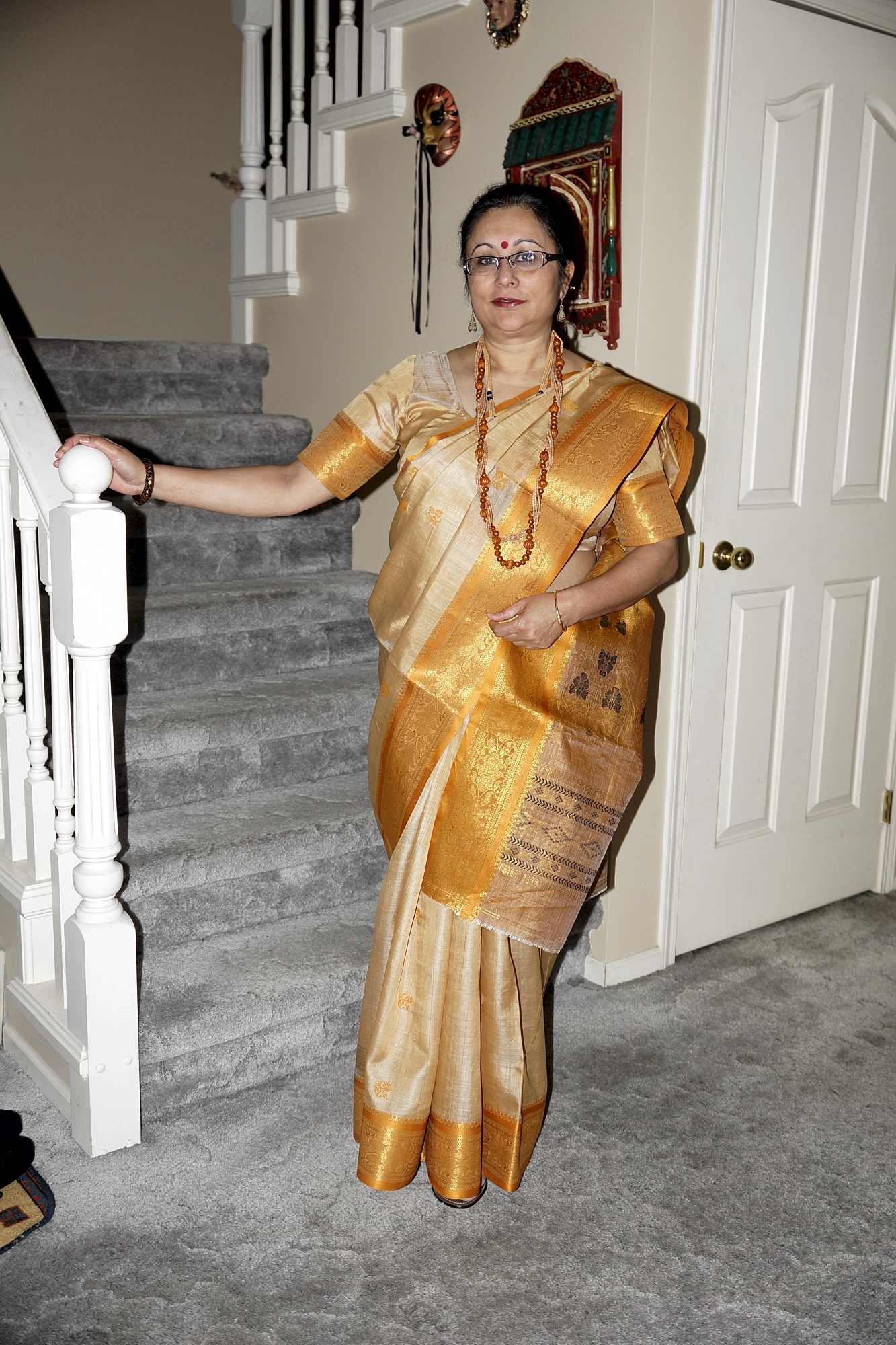
Anyhow, I took my time having a lazy breakfast, a large coffee, avoided Kurta Pajama for now and dressed in trouser, shirt and a jacket, and headed at Tan Lee da’s place.
Tan Lee da is a unique person. He was born in China and is a citizen of Canada. And yet, he is more Bengali at heart, and more attached to certain aspects of Santiniketan than myself. Describing him more fully would be outside the scope of this blog.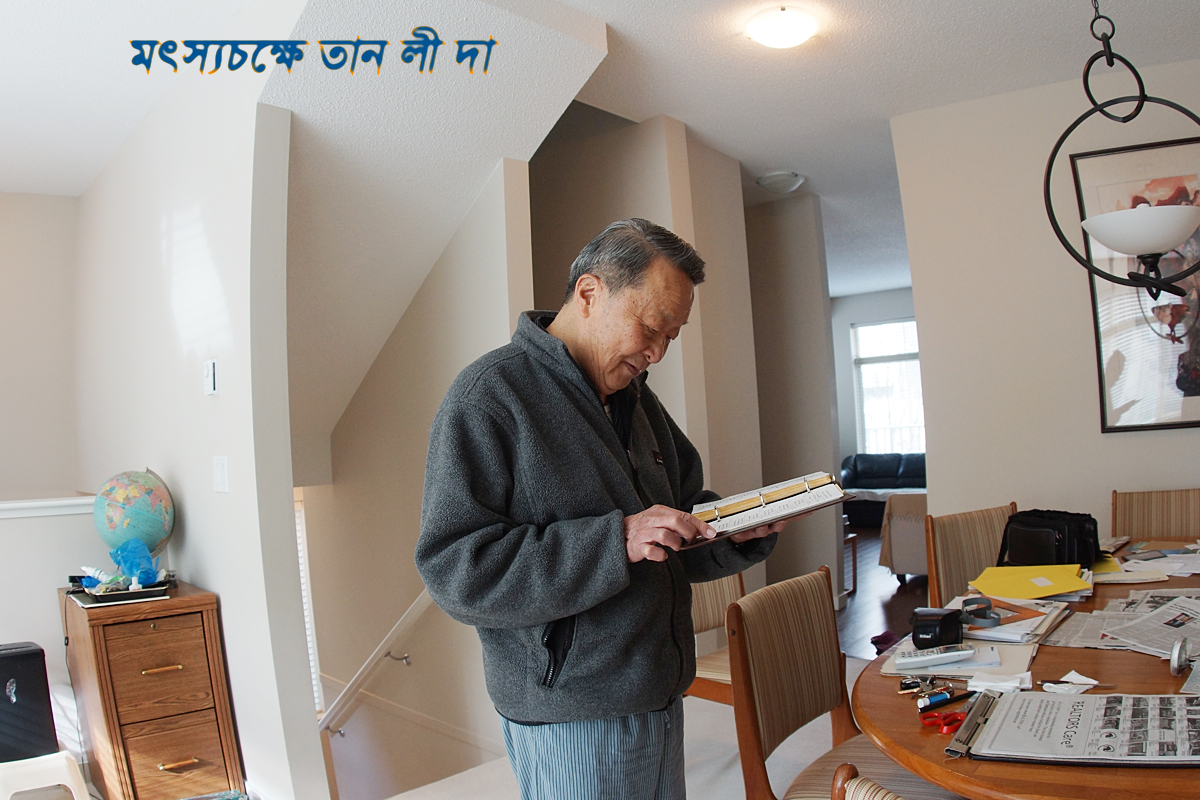
I had taken my camera along, with a standard medium zoom lens and a 16mm full frame fish eye lens. The fish eye was normally not used on people, as straight lines appear curved, but I had decided to use it at the puja, for fun. Thus, Tan Lee da became the first inadvertent subject of my experiment.
On the way to the temple, I was mainly engaged in explaining to Tan Lee da and Leena di about what I understood of the mass movement ongoing in Bangladesh regarding the trials of those accused of crimes against humanity during its struggle for independence in 1971.
We reached the prayer hall before noon. I did not make a head count, but suspect there were less than a hundred people present. I shook hands with everyone I knew and some I had not met before, and then headed for the snack section, to help myself with a cup of tea and some snacks, and met up with Dahlia and Ananya there.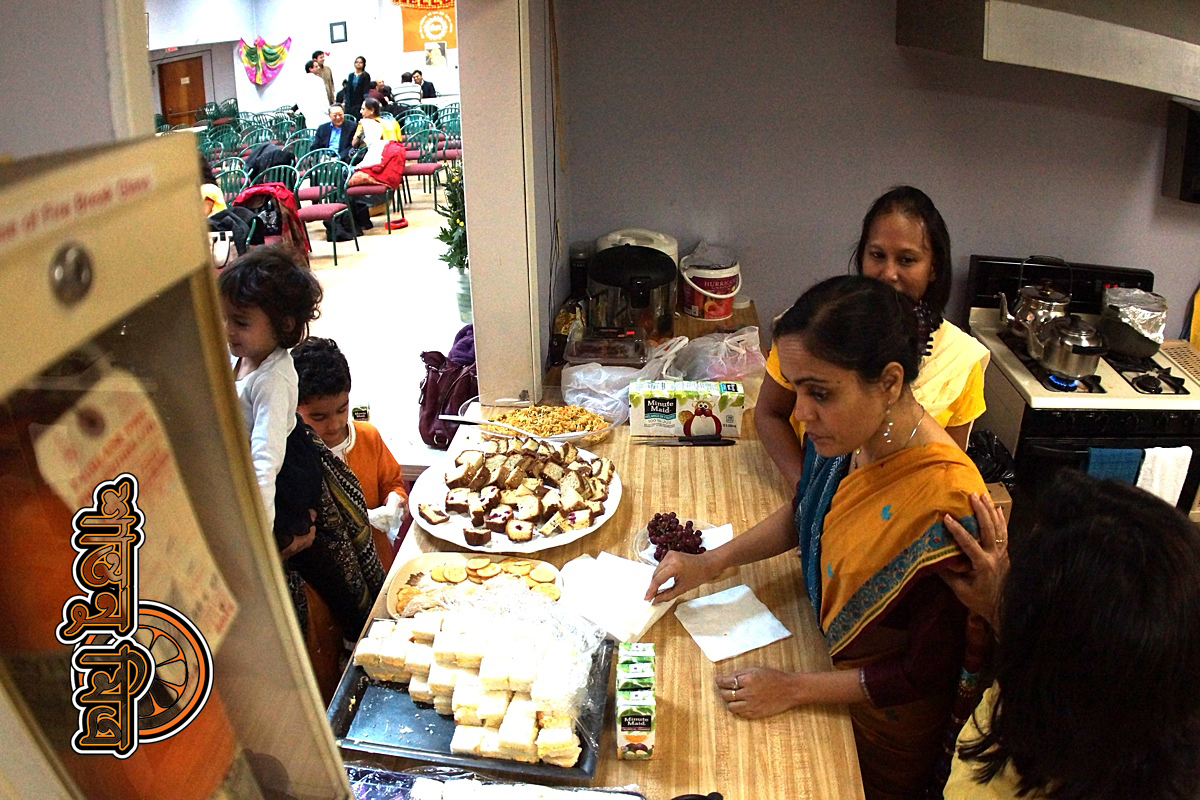
Looking around, with the ladies dressed so elegantly and staying close to the deity, I felt as if the ladies actually came for blessing of the Goddess, while the men perhaps come to look at the ladies.
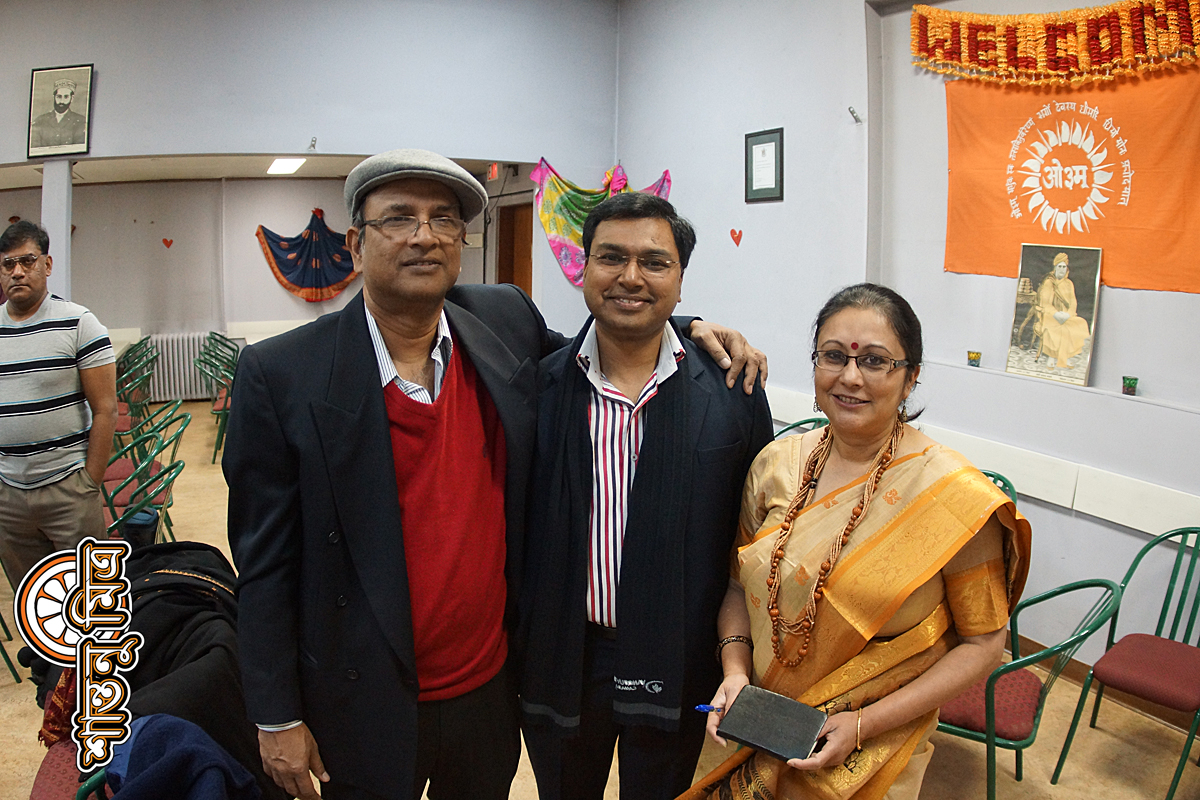
I had an interesting bit of discussion with Amlan Dasgupta and Siddharth Gupta, regarding corruption of high officials in Government and politics in almost all soceities, and how our own friends and buddies would often stay away from controversial issues that so concerned us. To me, it was not much use blaming politician if we were ourselves not willing to stand up for it to an extent and raise awareness.
The visit was valuable for me as I met up with a lovely group of people from the neighboring state of Assam. Anuradha took down their phone number, and we planned to have an evening of dinner and adda one of these days.
The youngsters were going to the Roundhouse Community Centre in Vancouver regarding a function in Bengali and to honor the 21th Feb Bhasha Andolan day remembrance as a key event in Bangladesh’s aspiration for freedom of expression, language, and government. I was invited by Amlan, but could not make it as my time was tied with Tan Lee da and Leena di.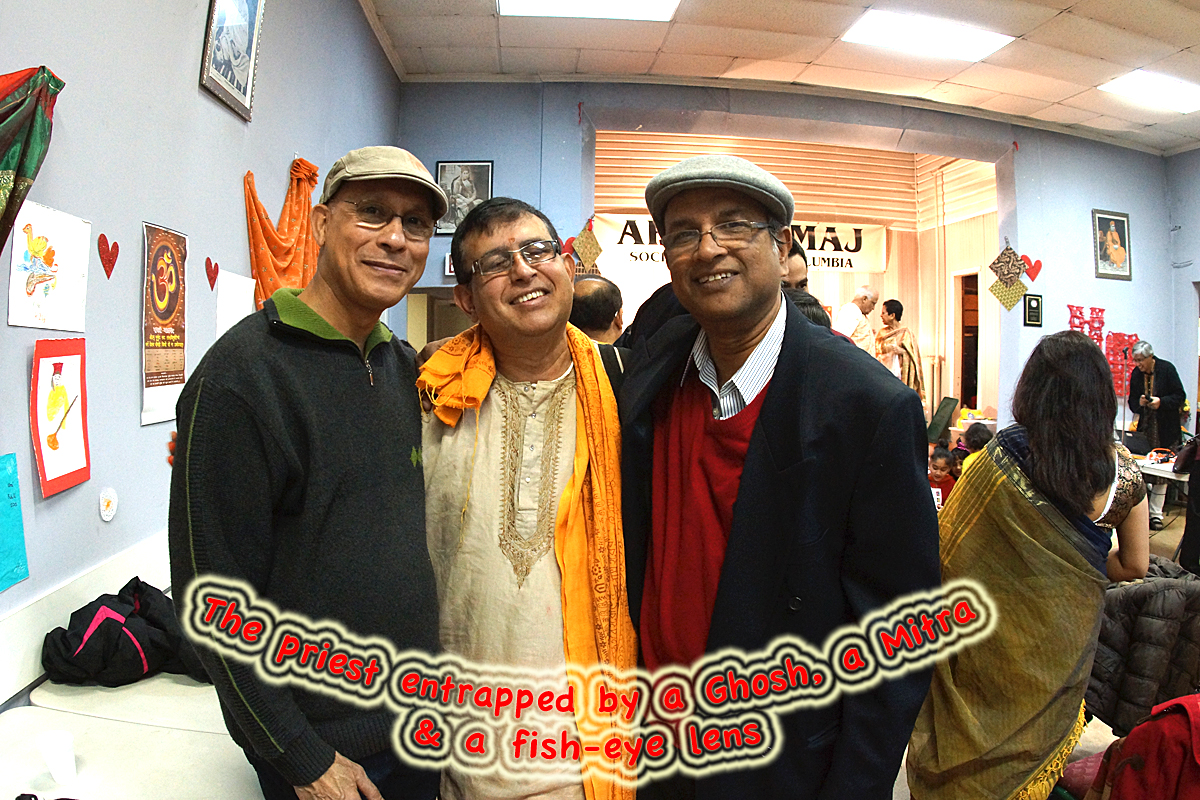
I did not stay long, as Tan Lee da and Leena di wished to return home early. Others stayed back for the music and dance sessions, which lasted into the evening. The ladies then went someplace for a further powwow, my wife included.
Anyhow, if was a pleasant way of spending a day, and I passed another year without consciously asking for the Goddess of knowledge for any blessing. To me, Saraswati is primarily a key historical river of ancient India that disappeared as the Himalayan ice age glaciers that fed the river receded and finally vanished at the Sivalik hills post ice age around four thousand years ago. To me, that river was the location where the first recognizable congregation of humans were laying down practices, rituals, lifestyles, and thoughts that would later come to be known as Hinduism.
I was not a religious person, and to me Hinduism is not even a religion that follows the conventional yardsticks of other mainstream religions. Lately I have come to question the centralized Governments of nation states as well as the concentration of power by mainstream religions. I have come identify more with agnosticism and a theoretical anarchy that is often professed by free thinking individuals such as Noam Chomsky and others. I am not a convert into it yet, since I do not know if horizontal form of local governance without vertical structure of hierarchy is at all possible for industrial societies with larger populations. We have several millennia of practice and getting hooked to a vertical system of power structure and Governance.
But, we can always ponder these issues, especially since the current vertical control model is clearly fraying at the edges, and cracks are beginning to show at its foundations.
On the drive homeward with Tan Lee da and Leena di, we broached the topic of Brahma Samaj and its decline, Arya Samaj as its current status, and what position Rabindranath Tagore took with regard to the perceived Hindu Samaj – Brahma Samaj divide of his time. People like Prasanta Mahalanobis and Sukumar Roy and their interaction with Tagore and the then Brahma Samaj were touched upon.
Not a bad way to spend a day.
Perhaps, in spite of my skepticism, the concept of Saraswati the Goddess had blessed me not so much with knowledge per se, but with a tendency to question everything I read or heard, and to analyze the information, filtering in what seemed believable at the time, and rejecting what appeared unlikely, and yet leaving the doors and windows open, for future changes in ideas.
I guess this was my way of relating to Saraswati, the river, the Goddess and the perception of knowledge.
